HP dm1z: Taking Fusion on the Road
by Dustin Sklavos on February 21, 2011 7:00 PM ESTFusion-Powered: Application and Futuremark Performance
This was my first experience with AMD's E-350 APU, a chip which has been the subject of some contention around here. Jarred and I are basically in agreement where performance is concerned and the general positive impact the chip can have on the mobile market: it's where netbooks probably needed to be all along, and should hopefully supplant Intel's lackluster Atom platform. Where we differ is our enthusiasm for it: Jarred feels Brazos was long overdue and isn't the quantum leap we were hoping for and expecting, which is a perfectly fair assessment. We needed Brazos a while ago, and AMD is late to this party.
That said, I'm happy AMD finally did show up. You'll see the E-350 isn't a massive jump forward from Atom, but it's enough of one to make the netbooking experience finally enjoyable instead of being a sluggish chore. Subjectively speaking, in regular use I found the dm1z to be nearly as responsive as my Lenovo ThinkPad X100e which is equipped with AMD's first generation Congo platform (though upgraded to an Intel X25-V SSD instead of the still-respectable Western Digital Scorpio Black mechanical drive.) So how does the E-350 actually fare when compared to mobile kit?
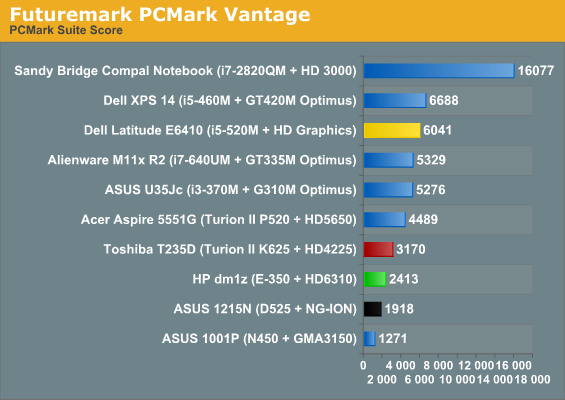
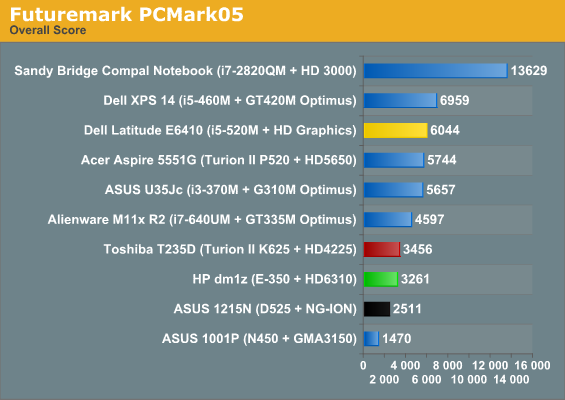
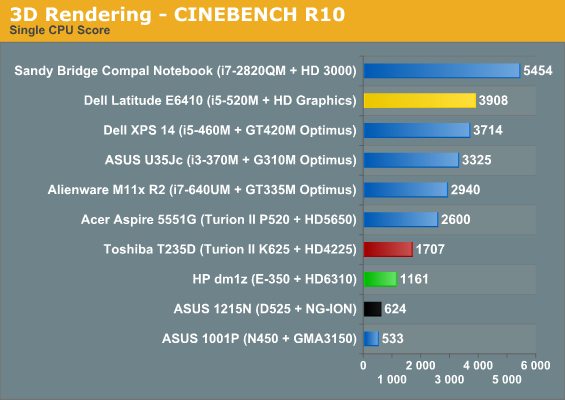
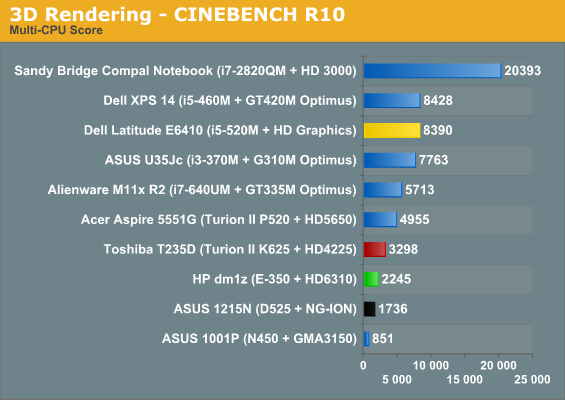
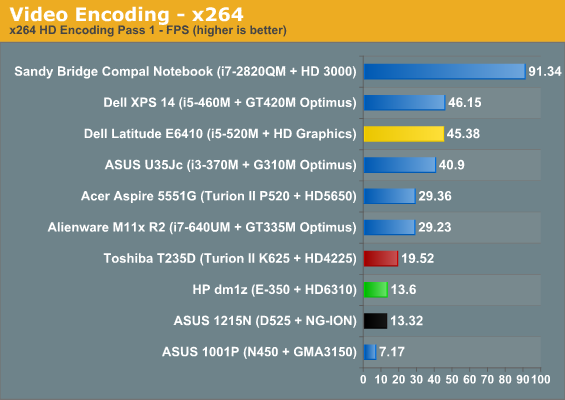
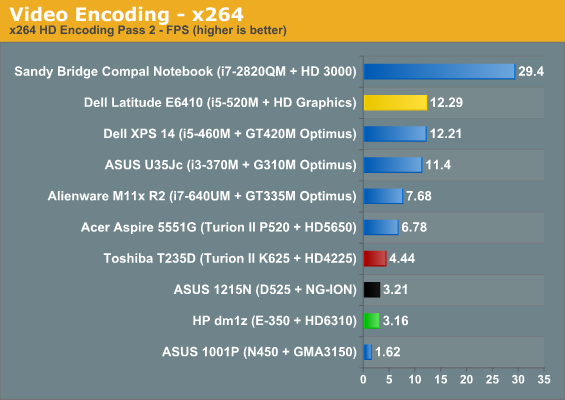
The first thing you'll notice is that while the E-350 generally cleans Atom's clock (the dual-core nettop D525 only comes out with a slight lead in the 2nd pass x264 encode), it's also generally about two-thirds as fast as the Nile platform's 1.5GHz Turion II K625. That's not too bad, but this is part of what Jarred's talking about, especially when you think about the Intel Core 2-based CULV kit that periodically kicks around the market (becoming stunningly rarefied). CULV hardware has also floated around the price point the dm1z is hitting shelves at, too, but it was fairly inconsistent. On the flipside, it does beat dual-core Atom equipped with NVIDIA's NG-ION, and this is a trend that's going to continue.
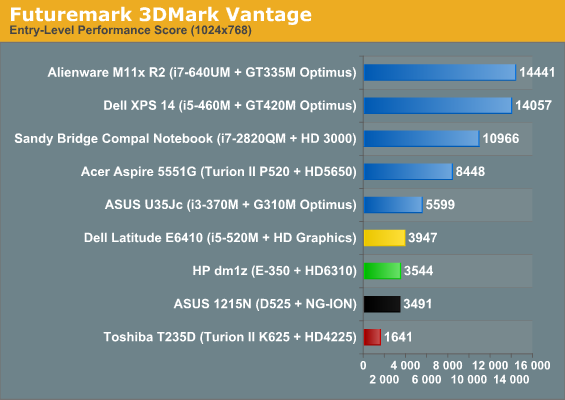
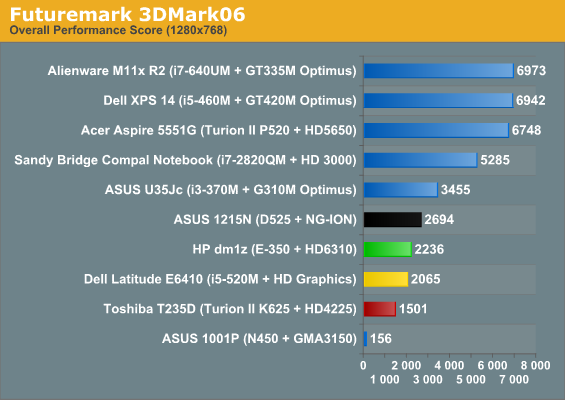
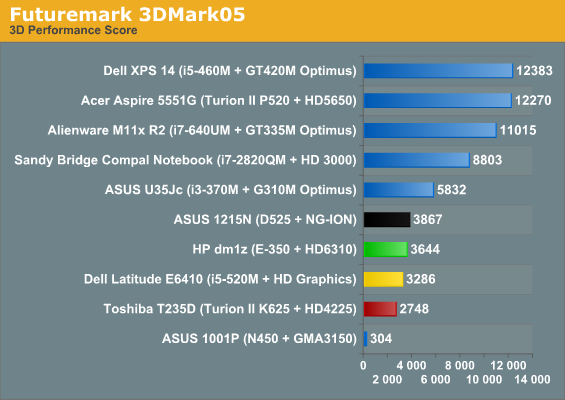
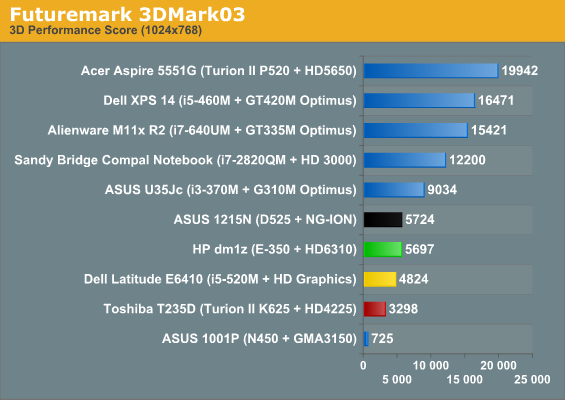
In 3DMark the E-350's integrated Radeon HD 6310 generally hangs out in the neighborhood of NG-ION, but it soundly beats Intel's last generation IGP (with better drivers and more stable performance to boot), and embarasses the Nile platform's Radeon HD 4225. That's not too surprising: in terms of raw GPU power the HD 6310 features twice the number of stream processors and a higher core clock.
If anything, the HD 6310 shows just how long in the tooth AMD's current IGP has really gotten: when it debuted as the 780G, it was a revelation, offering the best IGP performance bar none. The problem is that AMD just let it sit, offering new model numbers with no real performance increase outside of adding DirectX 10.1 support and bumping clocks slightly in some cases while serving us a warmed over Radeon HD 4550 in the form of the Radeon HD 5450 when they really should've just been integrating that hardware into their chipsets.
Ah well. With Brazos here now and Llano on the horizon, the era of AMD integrated graphics parts wearing out their welcomes should come to a close.










108 Comments
View All Comments
JarredWalton - Tuesday, February 22, 2011 - link
Funny thing is that I even reviewed something like that:http://www.anandtech.com/show/2503/2
$2000 ($2600 with a 1st-gen SSD) and you were still saddled with Intel's GMA X3100. Look at the performance scores in 3DMark03-06 and PCMark05; heck, it even has Cinebench 10 results in there. So today you get roughly the same performance as the old Core 2 Duo U7500, with six times the graphics performance, and about twice the relative battery life, all for one-fifth the price. That's a pretty good advancement for only three years!
swaaye - Tuesday, February 22, 2011 - link
I think that in a 11.6" form factor you can do better. With this thing you're plunking down a good amount of money for some very basic performance. and GMA X3100 is not that much of an issue for most people. But if price is all that matters, sure this is a decent choice I suppose.I'd rather see Brazos used in a 9" netbook, myself. Really take advantage of its low power consumption and heat output.
Penti - Tuesday, February 22, 2011 - link
You can, but not for 449 USD. Rember Atom netbooks costs as much if not more when they come with W7HP and Crystal HD accelerator. Especially if you want a bigger battery then some anemic 3-cell. There's even no need to special order this (bto). If you go down to ridiculous small batteries, there's literally not much of a point of it. If you want something like a ULV or normal Core i5 in it you will have to pay 250 USD just for the CPU, add 40 USD for chipset. Add in TFT-panel, motherboard pcb and associated components, wireless, hdd, battery, keyboard, touchpad, memory and case(charger etc) and it's already at about 750 for the cheapest possible configuration. Probably 800 in real world. I.e another product. Built in support for basics (today) such as H.264 and H.264 flash video acceleration is key here. Not that you almost can game on it. It replaces the dualcore higher end atom netbooks and makes them obsolete. With this setup your high-def online videos works, no matter if it's flash or netflix Sliverlight. Not so much on netbooks with atom, even with the Crystal HD accelerator. Adobe has real problems with those kinds of platforms till they have moved over to a real video oriented workflow like they are trying to do with stage video api. It solves todays needs.Hell it's even fast enough to do high res software decoded H.264 with CoreAVC. It's pretty important because you can't always muck about and reencode files and reencoding files takes a long time.
This is about filling and meeting the needs of the low-end. AMD can keep TSMC busy with these I suppose.
swaaye - Tuesday, February 22, 2011 - link
I just dumped a HP 12.1" from 2009 which had a Turion Neo X2 1.6 GHz (faster than Brazos) with a discrete Radeon 3450. The Turion was not exactly snappy and the 3450 was pretty sad overall. It was passable yes, but not really impressive. I got it as a factory refurb for $450 but they retailed for around $800.silverblue - Wednesday, February 23, 2011 - link
There's a couple of differences. Brazos supports more instruction sets as well as a faster IMC (albeit single channel). The performance difference should be slight, if anything.swaaye - Wednesday, February 23, 2011 - link
According to another look at Brazos here on Anandtech, an Athlon 64 X2 at 1.5 GHz can be over 20% faster per clock in some applications. That's not slight. Sometimes they are similar, but then other times you see 20% slower which is quite ugly. A 1.5 GHz Athlon 64 X2 is already very slow.swaaye - Wednesday, February 23, 2011 - link
I shouldn't have said per clock. The comparison was an Athlon 64 X2 1.5 GHz vs. Brazos 1.6 GHz.fshaharyar - Tuesday, February 22, 2011 - link
The build up to the fusion was very good. But I'd like to say they late by 6 months to the party.If they had intrudoced this product to the market 6 months back it would have stolen the Intel thunder and their would have been a huge shakeup in the netbook market.
But still not taking anything away from their success we will see better alternatives in the mobile market with this teck piece.
AMD will have ensure that they refresh there current gen proc. every 8-9 months.
with regards to their GPU refresh as well as plan their CPU strategy.
Hal2011 - Tuesday, February 22, 2011 - link
NBS=No Glossy ClubWould love a new, little portable but waiting till manufacturers figure out that glossy screens are absolute crap. They are only there to hide the poor screen quality and to look good in the shop. Even on a cloudy day outside the local coffee shop, you still only look in a mirror. Hey, a mirror is more portable if I needed one! A small notebook is made to be used all over the place but these can't. Am I the only one?
cosmotic - Tuesday, February 22, 2011 - link
"The only thing that hurts about using the dm1z, really, is the amount of bloatware it ships with from HP.""The only major dents in the dm1z's armor are the poor screen and constantly running fan."
"The only fly in the ointment is that while the E-350 is a step up, it's a long overdue one and it's not quite the huge one we needed." … "but we don't need more cores in the E-350; we need faster ones."
Sound's more like three problems instead of one.